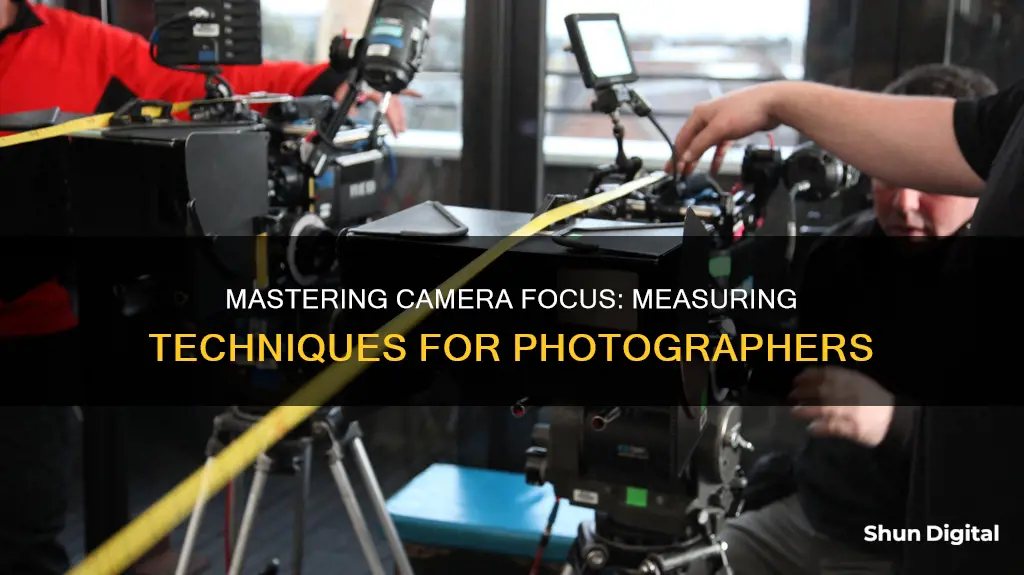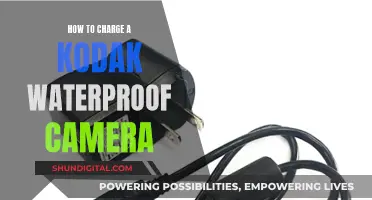
Measuring camera focus is a crucial aspect of photography and filmmaking, ensuring that the desired subjects are sharply in focus. The process involves determining the distance between the camera's film or sensor plane and the subject, which is then translated into lens settings. This is particularly important in scenarios like macro photography, where the working distance between the lens and the subject is crucial to capture crisp and clear images. Various tools and techniques, such as tape measures and focus marks, are employed to achieve precise focus, enhancing the overall visual quality of the final product.
| Characteristics | Values |
|---|---|
| Image quality | Sharpness and contrast |
| Camera system control variables | Focus and exposure |
| Measurement starting point | Film/sensor plane of a camera |
| Measurement starting point exceptions | ENG (Electronic News Gathering) lenses |
| Measurement ending point | Subject you are focusing on |
| Measurement ending point details | Measure to the part of the subject you want in focus |
| Focus | Set and determined through distance |
| Lens working distance | Amount of space in front of the lens |
| Minimum focus distance | Distance from the imaging sensor to the subject |
| Flange focal distance | Distance from the sensor to the rear of the lens mount |
| Focus measurement tools | Tape measure, monitors, viewfinders |
What You'll Learn

Start at the film/sensor plane
The film/sensor plane is the starting point for measuring focus distance. If a lens specification states that its closest focus point is a certain distance, it means that distance from the film/sensor plane. This is because, due to the viewfinder and prism housing, it is not practical to mark on the camera body where the sensor is located.
The film/sensor plane is especially important in macro photography, where the difference between "rough distance" (the distance from the camera to the subject) and actual distance matters when calculating exposure or magnification.
When using ENG (Electronic News Gathering, or TV/Broadcast) lenses, you won't be able to measure from the film/sensor plane. These lenses are recognisable by a green stripe around the barrel, and you will need to measure from the front of the lens.
Converting Camera Raw Files: Bulk JPEG Conversion Tips
You may want to see also

Measure to each subject in the scene
When measuring to each subject in the scene, it's important to remember that the subject you're focusing on will be the next point of measurement. If there are multiple subjects in a scene, you will need to take multiple measurements. Most of the time, the subject is a character, but not always. It could be a door handle, a telephone, or even a skeleton on a road.
Whatever the subject, you need to measure the part of it that you want to be in focus. This is crucial. You can't just measure the distance to the subject itself. Your depth of field may be shallow, meaning only parts of a subject will be in focus. That's why you measure the most important part of a subject. For humans, this is usually the eyes. It would look strange if the tip of someone's nose was in focus but their eyes were not.
So, if you're filming a person, you would measure the distance to their eyes and set your focus there. If you're filming an inanimate object, you would choose the most important or interesting part of that object to focus on.
Camera Tickets: Insurance Impact in Ohio
You may want to see also

Measure to a few reference objects
When measuring camera focus, it's important to have reference points to ensure your subject remains in focus. This is especially important when filming unpredictable scenes, such as a choreographed fight scene with loose blocking. In such cases, you'll want to establish reference marks by identifying points in the room that you can measure.
Look for objects in your view from beside the camera that give a clear indication of the actor's relation to them. It's best to have reference marks in front of, beside, and behind the points of action to prepare for any scenario. For example, if the actors are fighting near a couch, use that as a reference point. If they're near a table or bookshelf, use that instead.
During the scene, match the position of the actors to these references and adjust your focus accordingly. This technique ensures that your subjects remain in focus, even if their distance from the camera varies.
Additionally, when focusing on humans, ensure that the eyes are in focus. It can look odd if another part of the face, like the nose or ears, is in focus while the eyes are not.
Focusing KPC-EJ230 High-Res Bullet Cam: Tips for Crisp Footage
You may want to see also

Transfer your marks
The final step in the process of measuring for focus is transferring your marks onto the lens, follow focus, or to your "mental map". The most important marks, such as character landing marks, will go on your lens or follow focus, while less important marks, such as reference points, you make a mental note of.
If you make enough of these mental notes, you will build a "mental map" of the room in your mind. This will help you to adjust your focus during the scene. For example, if the director tells the actors to play freely in a space, you can use your mental map to match the position of the actors to your reference points and adjust your focus accordingly.
It is important to note that the traditional method of using a paper tape measure is rarely observed on most sets today due to advancements in technology. Laser range finders, Cinetape, and laser tape are commonly used as faster alternatives.
Mastering Adjustment Brush Undo in Camera Raw
You may want to see also

Measure sharpness and contrast
Measuring sharpness and contrast is a key aspect of photography, and it involves a range of factors that can be adjusted to varying degrees. Here are some techniques to measure and improve the sharpness and contrast of your images:
- Acutance: Acutance is a subjective perception of sharpness related to the edge contrast of an image. It is influenced by the amplitude of the derivative of brightness concerning space. While an increase in acutance does not enhance the actual resolution, it makes the image appear sharper due to the nature of the human visual system. Acutance can be improved through post-processing or by using specific lenses and filters.
- Camera Resolution: The resolution of your camera impacts the sharpness of your images. It is measured in megapixels, and generally, a higher number of pixels results in greater detail and sharpness. However, other factors like pixel size, sensor size, lens quality, and settings also play a role in determining the overall sharpness.
- Focus and Sharpness: These two terms are closely associated. An out-of-focus image will have a low acutance and a consequent lack of sharpness. Proper focusing techniques, such as selecting the autofocus mode and autofocus area according to the subject, are crucial for achieving sharp images.
- Shutter Speed and Motion Blur: Slow shutter speeds or camera shake can cause motion blur, leading to a loss of sharpness. To maintain sharpness, use appropriate shutter speeds and consider using a tripod to stabilise your camera.
- Aperture and Depth of Field: Aperture settings also affect sharpness. Wide apertures decrease the depth of field, resulting in only a small area of the image being in sharp focus. On the other hand, using very narrow apertures can lead to the optical phenomenon of diffraction, reducing sharpness. The ideal aperture for maximum sharpness, known as the "sweet spot," varies depending on the lens but is usually found by opening 2 to 3 stops of light from the widest aperture.
- Digital Noise and ISO: High ISO settings can introduce digital noise, which affects the sharpness of your images. This is particularly noticeable in night photography or long exposure photography. Applying techniques to minimise digital noise is essential for maintaining image sharpness.
- Lens Quality: The quality of your camera lens significantly impacts the sharpness of your images. Basic kit lenses might not deliver the desired sharpness due to their optical quality. Investing in higher-quality lenses can drastically improve the sharpness and overall quality of your photographs.
- Post-Processing Techniques: Various post-processing software and plugins are available to enhance the sharpness of your images. Programs like Lightroom or Photoshop offer sharpening techniques to increase the perceived sharpness by enhancing edges or transitions and reducing digital noise.
Unveiling Camera Raw Panel in Bridge: A Step-by-Step Guide
You may want to see also
Frequently asked questions
The first step in measuring camera focus is to start at the film/sensor plane of the camera, which is located behind the lens. The only exception to this is when using ENG (Electronic News Gathering) lenses, which are identified by a green stripe around the barrel. With these lenses, you measure from the front of the lens.
The focus distance is measured from the film/sensor plane to the subject or object you are focusing on. If using ENG lenses, measure from the front of the lens to the subject.
Measuring the focus distance is important because it allows you to set the focus accurately. By measuring the distance, you are telling the lens which light rays at a certain distance you want focused on the film or sensor plane.
The minimum focus distance (MFD) is the distance from the imaging sensor to the subject, as specified by the manufacturer. The working distance is the amount of space you have to work with in front of the lens. It is calculated by subtracting the manufacturer-specified lens length from the MFD.







